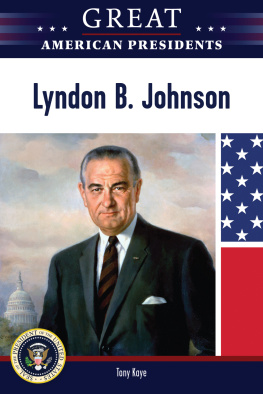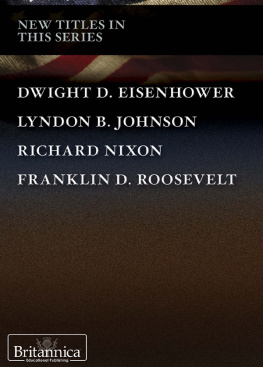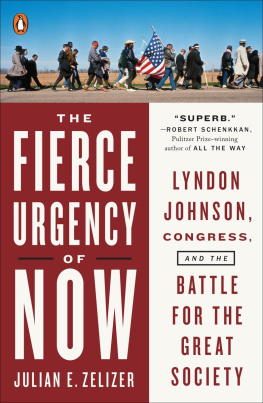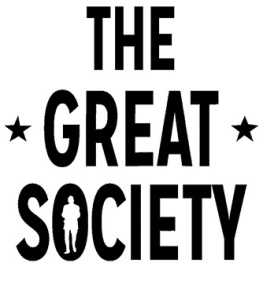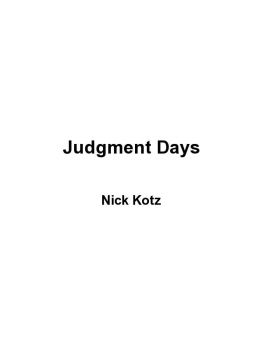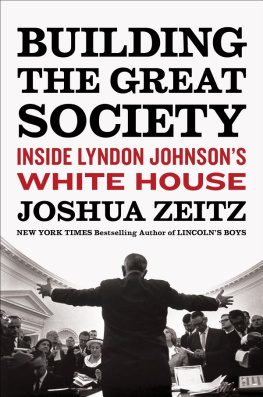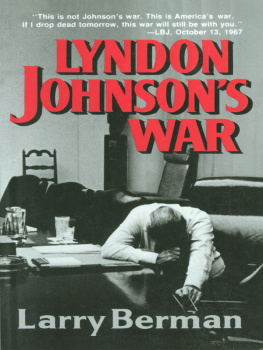Tony Kaye - Lyndon B. Johnson
Here you can read online Tony Kaye - Lyndon B. Johnson full text of the book (entire story) in english for free. Download pdf and epub, get meaning, cover and reviews about this ebook. year: 2016, publisher: Infobase Publishing, genre: Non-fiction. Description of the work, (preface) as well as reviews are available. Best literature library LitArk.com created for fans of good reading and offers a wide selection of genres:
Romance novel
Science fiction
Adventure
Detective
Science
History
Home and family
Prose
Art
Politics
Computer
Non-fiction
Religion
Business
Children
Humor
Choose a favorite category and find really read worthwhile books. Enjoy immersion in the world of imagination, feel the emotions of the characters or learn something new for yourself, make an fascinating discovery.
- Book:Lyndon B. Johnson
- Author:
- Publisher:Infobase Publishing
- Genre:
- Year:2016
- Rating:4 / 5
- Favourites:Add to favourites
- Your mark:
- 80
- 1
- 2
- 3
- 4
- 5
Lyndon B. Johnson: summary, description and annotation
We offer to read an annotation, description, summary or preface (depends on what the author of the book "Lyndon B. Johnson" wrote himself). If you haven't found the necessary information about the book — write in the comments, we will try to find it.
LBJ designed key Great Society legislation on civil rights, Medicare, and Medicaid, and increased Americas involvement in the Vietnam War. This biography follows Johnson from his childhood in the Texas Hill Country to his career on Capitol Hill, and
Lyndon B. Johnson — read online for free the complete book (whole text) full work
Below is the text of the book, divided by pages. System saving the place of the last page read, allows you to conveniently read the book "Lyndon B. Johnson" online for free, without having to search again every time where you left off. Put a bookmark, and you can go to the page where you finished reading at any time.
Font size:
Interval:
Bookmark:
Copyright 2016 by Infobase
All rights reserved. No part of this publication may be reproduced or utilized in any form or by any means, electronic or mechanical, including photocopying, recording, or by any information storage or retrieval systems, without permission in writing from the publisher. For more information, contact:
Chelsea House
An imprint of Infobase
132 West 31st Street
New York NY 10001
ISBN 978-1-4381-4488-7
You can find Chelsea House on the World Wide Web
at http://www.infobaselearning.com
On Tuesday, November 19, 1963, Vice-President Lyndon B. Johnson arrived at his Texas homestead to check preparations for two house guests expected that weekend at the LBJ Ranch: President John F. Kennedy and his wife, Jacqueline. Poland Spring Water and Ballantine's scotch were purchased for the president's pleasure; champagne and Salem cigarettes for the First Lady's. Phones were installed throughout the house, carefully placed for the president's convenience, but tucked away inconspicuously so as not to divert him from the main object of his visit, a full day of relaxation. The president's stay at the LBJ Ranch was to conclude a two-day swing through Texas that would lay the groundwork for Kennedy's reelection campaign in 1964.
But as Johnson surveyed the arrangements and pronounced himself pleased with the results, he had no way of knowing the president would never arrive. Three days later, an assassin's bullet would make Vice-President Lyndon B. Johnson the 36th president of the United States. Johnson had become a popular figure in Texas politics over the course of three decades in Congress, rising through the ranks of the Senate to become majority leader, the top position in the upper chamber. Through his mastery of Texas politics and the intricacies of the Senate, Johnson acquired something of a national following as a moderate in the Democratic Party, known for his ability to build a consensus and get things done.
In 1960 Johnson had run for president. The campaign for the nomination of the Democratic Party narrowed down to Johnson and Senator Kennedy of Massachusetts. Kennedy emerged the winner. The campaign was hard fought, but the two candidates developed a mutual admiration over the course of it. Kennedy chose Johnson to be his vice-presidential nominee. Recognizing Johnson's popularity in his home state, Kennedy left the campaign in Texas to his running mate. Johnson stumped brilliantly for the ticket, crisscrossing the state time and again. His efforts paid off in a narrow victory for the liberal Kennedy in conservative Texas. The votes Johnson garnered in Texas were crucial to Kennedy's victory over Republican nominee Richard Nixon in one of the closest presidential elections in history.
But many voters in the South, including those in Texas, opposed the Kennedy administration's liberal policies. In Johnson's absence, liberals and conservatives in the state Democratic Party had begun feuding in rough-and-tumble Texas fashion. Kennedy and Johnson hoped a swing through the state would shore up the administration's popularity and reunite the squabbling factions for the upcoming election.
Their hopes seemed well founded on Friday morning, November 22, when Johnson brought his sister, Lucia Alexander, to meet President Kennedy in his suite at the Hotel Texas in Fort Worth. The president was in high spirits. Large and enthusiastic crowds had greeted Kennedy in San Antonio and Houston the day before. Despite some hostile remarks in the conservative press, the trip seemed to be going well. "We're going to carry two states next year if we don't carry any others," Kennedy told Johnson confidently. "Texas and Massachusetts."
"Oh, we're going to do better than that, Mr. President," Johnson replied. They were the last words Vice-president Lyndon B. Johnson would ever speak to President John F. Kennedy.
Air Force One touched down in Dallas at 11:40 A.M. under a clear sky and a bright sun. Standing at the head of the receiving line on the tarmac of Love Field, Johnson was struck by how radiant Jacqueline Kennedy looked in a pink suit and hat as she stepped from the plane. Taking her hand, Johnson shrugged boyishly at the strained formality of their fourth airport greeting in 24 hours. The receiving line followed the Kennedys to a crowd of about a thousand Texans waiting to greet the First Family, Johnson, and his wife, Lady Bird. After shaking hands and greeting old friends, the Johnsons took their place in the motorcade that would wind through downtown Dallas.
The motorcade pulled out from Love Field at 11:55 A.M., led by the presidential limousine carrying Governor John Connally of Texas and his wife in the front seat and the Kennedys in the back. A Secret Service car and the vice-presidential limousine carrying Lyndon and Lady Bird Johnson and Texas senator Ralph Yarborough followed closely behind.
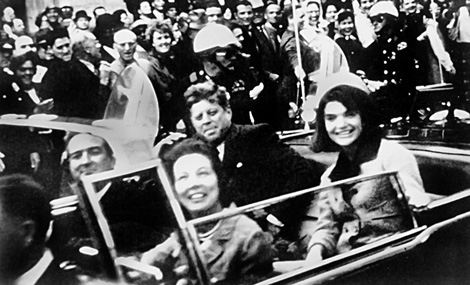
Although blurry, this photograph shows President John F. Kennedy and Mrs. Kennedy in the backseat and Governor John Connally and Mrs. Connally in the front seat of the car during the motorcade through Dallas on November 22, 1963. Just after this picture was taken, President Kennedy was assassinated. Vice President Lyndon Johnson became president later that day.
Source: Library of Congress. Prints and Photographs Division.
The president stopped the motorcade twice as it made its way up Alto Drive, first for a group of children holding a placard saying MR. PRESIDENT, PLEASE STOP AND SHAKE OUR HANDS, and later to greet a group of nuns. As the motorcade approached the center of town, the crowds lining Live Oak Street and the affection shown the president grew. The smiling children waving signs, and the people hanging out of office windows cheering and pouring confetti down upon the motorcade convinced Johnson that the president was right in predicting they would carry Texas in 1964.
At 12:30 P.M., the motorcade turned right off Main Street onto Houston Street, then left onto Elm, which would lead to an underpass and then onto Stemmons Freeway. Just as the vice-presidential car turned onto Elm Street, Johnson was startled by what sounded like an explosion coming from the back of the motorcade. Before he could turn to see what it was, Secret Service agent Rufus Youngblood spun around from the front seat and pushed the vice-president down to the floor of the car.
With Youngblood sitting on his shoulder, Johnson craned his neck to his right to make sure that Lady Bird and Senator Yarborough were unhurt. Then he heard another explosion shake the air. A Secret Service radio squawked from the front seat. The limousine accelerated so suddenly up over a curb and around a corner that it seemed to Johnson as if the car were riding on two wheels. As the motorcade sped past the Trade Mart where President Kennedy was scheduled to deliver a speech, Youngblood told the vice-president that they were going to a hospital. Crouching in the back seat, Johnson heard Youngblood speak into the crackling radio several times. "When we get to the hospital," Youngblood told Johnson, "you and Mrs. Johnson follow me and the other agents."
The car stopped a moment later. A phalanx of agents surrounded the Johnsons as they got out of the car, and walked them quickly into the hospital. Their appearance at the hospital kindled a rumor that the vice-president had suffered a heart attack. In the frenzied moments that followed, as the eyes of the nation fastened upon Parkland Hospital, the press would circulate the rumor throughout the country.
Johnson, of course, knew they had not come to the hospital for his benefit. He realized that the explosion he had heard in the motorcade must have been gunfire. But as he and Lady Bird waited in a small room in the hospital, he did not know who had been injured in the shooting. Emory Roberts, the Secret Service agent in charge of the White House, was the first to inform Johnson that President Kennedy had been seriously wounded and that Governor Connally had been injured. Johnson would later recall that he was stunned at the news about "my president and leader" and Connally, "my confidant and friend." In a single moment, Johnson thought, "the day, which had started out so cheerfully, had turned into a nightmare."
Font size:
Interval:
Bookmark:
Similar books «Lyndon B. Johnson»
Look at similar books to Lyndon B. Johnson. We have selected literature similar in name and meaning in the hope of providing readers with more options to find new, interesting, not yet read works.
Discussion, reviews of the book Lyndon B. Johnson and just readers' own opinions. Leave your comments, write what you think about the work, its meaning or the main characters. Specify what exactly you liked and what you didn't like, and why you think so.

